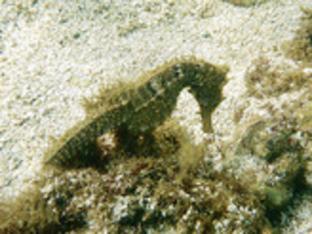Published in the Ocean Watch column, Honolulu Star-Advertiser © Susan Scott
September 12, 2011
I’m revisiting the subject of seahorses because they’ve been revisiting me. Since I wrote last month about my first sighting of a live seahorse in Hawaii, or anywhere in the wild, four more have shown up on two occasions. And two of those little darlings put on a show so amazing that if I hadn’t gotten pictures of them (blurry but proof enough), I might think the scene had been a product of wishful thinking.

Photo by Susan Scott
This resting sea horse, about 6 inches long, was seen on the North Shore.
This brilliant performance occurred in bright sunshine in calm water barely over my head. I was snorkeling and drifting with the current when along came a 6- to 8-inch-tall sea horse. She was swimming upright near the bottom and against the current, going forth as smoothly as if riding a Segway.
A sea horse has one fin on its back, used for propulsion, and a tiny fin under each eye for steering. But the fins are so small, and flutter so fast, like hummingbird wings, I couldn’t see them working.
I followed along, passing coral heads, sand patches and clumps of seaweed for maybe 50 yards. And still she glided on. Is she searching for food? I wondered. Looking for cover? Wandering aimlessly?
Discovering this sea horse’s mission ranks among the top marine animal thrills of my life: She was meeting her mate.
Male and female sea horses are monogamous during each breeding season, and maybe for life, one to five years. The two rendezvous each morning with the female swimming to the male’s territory, about 10 feet square. The female’s range is 10 times that or more.
After meeting, the two dance and embrace by wrapping their tails together. Eventually, the female lays her eggs into the male’s pouch, where he fertilizes them internally. He carries the eggs until they hatch, and out pop dozens of tiny, perfectly formed sea horses.
My loving couple circled one another, bobbing and linking for about 30 minutes. If the female deposited her eggs into her mate’s pouch, I didn’t see it, but I didn’t care. They had already given me a once-in-a-lifetime thrill.
I got so excited about finding these rare jewels in Hawaii that I flew to Kona to visit the sea horse farm, Ocean Rider. There I learned that due to collecting and pollution, sea horses are endangered worldwide. Also, sea horses taken from the wild don’t eat aquarium food and soon die. Please leave these treasures in the ocean.
Most of the sea horses raised for aquariums at Ocean Rider are a hardy species not found in Hawaii waters. To ensure that an alien species isn’t introduced, Hawaii residents are not allowed to buy Ocean Rider sea horses.
———
On the Net:
Ocean Rider: www.seahorse.com